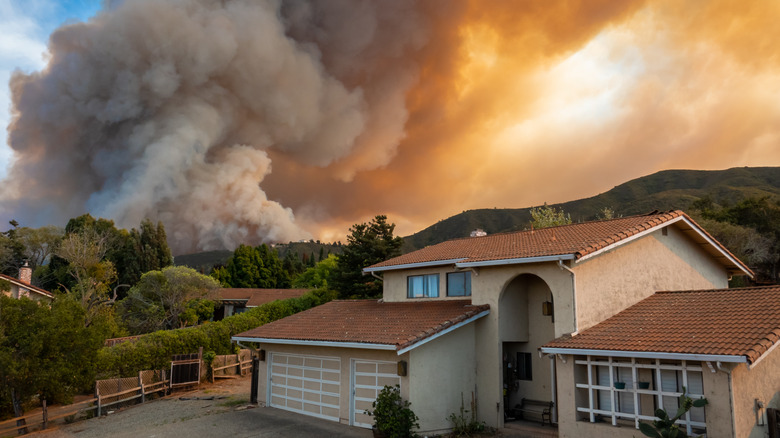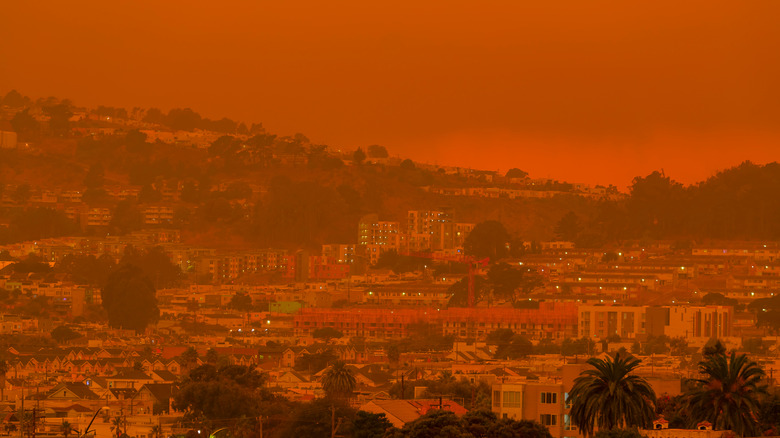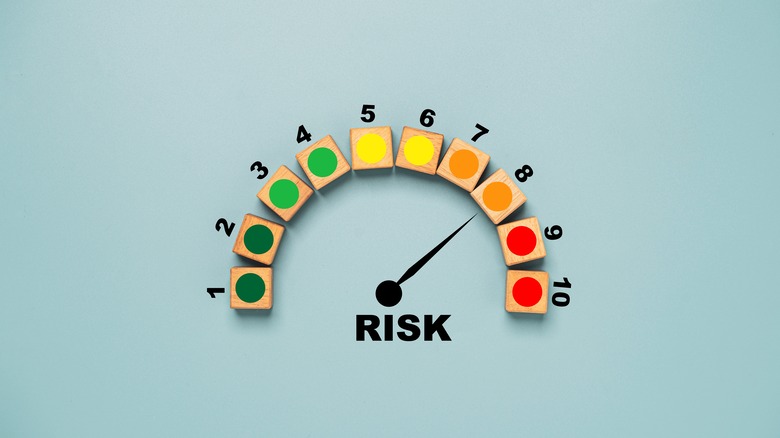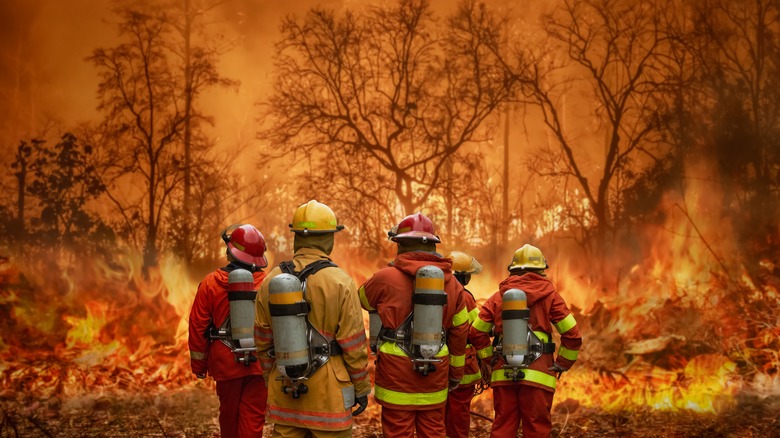The 2022 Homeowner's Guide To Finding Insurance In Fire-Prone Areas
Wildfires are growing in severity and number across the United States West Coast. As a result, insurance policies that cover fire damage have become a necessity for millions of homeowners in a wider swath of the country. Growing fire incidence has also led to a dramatically increased level of difficulty when it comes to purchasing fire insurance. This has influenced both the price of coverage and in some instances, the ability of homeowners to get covered in the first place.
Pew notes that homeowners who live in heavily forested areas, those whose homes are built against fire-prone slopes, and others are finding it increasingly difficult to secure coverage for their homes against the damage that a fire may cause. Adding to insurers' concerns is the more than $9 billion in wildfire damage caused to properties in 2018.
Of course, insurance protection relating to fire damage is an important element that all homeowners should consider adding to their portfolio of coverage products, yet this feature is essential in the Pacific Northwest and its surrounding regions. There has been a marked uptick in the volume of acres burned nationwide in yearly wildfires over the last four decades (via U.S. Environmental Protection Agency). However, with a few key features in mind, finding coverage doesn't have to be an effort in futility.
A growing concern in West Coast communities
The urgency surrounding fire protection is only growing for homeowners in areas of the country at the greatest risk of damage from wildfires. But with insurance products becoming increasingly hard to come by, homeowners may be feeling a concurrent sense of anxiety over these integrated effects of global climate change.
Verisk reports that more than 4.5 million homes in the United States are classified as being at high or extreme risk from the seasonal impact of wildfires. This means that wildfire spread affects millions of Americans and should be taken seriously. USDA research shows that 84% of all wildfires can be traced back to human activity (via National Park Service). Therefore, wildfires are both a significant concern for homeowners and a very human-driven, and self-inflicted problem. Those in the American West are experiencing a growing trend in both the number of wildfires over the long term and the volume of their destruction for a number of reasons. A bevy of climate change-related consequences is leading to dryer conditions throughout this widespread area (via The New York Times). Mixed with a dryer landscape and ecosystem of native plant life than in the East, conditions have been trending toward more intense and more prolonged fire seasons for years.
The most obvious response that homeowners have made in the face of these growing dangers is the use of more comprehensive fire protection products. Builders have made use of smarter housing design, and homes are seeing greater coverage from insurance providers. Homeowners without protection place themselves at risk of losing everything if a wildfire suddenly shifts course and ultimately consumes their home and everything in it. The consequences are too great to leave this ballooning danger to chance.
The importance of fire coverage for homeowners
Fire damage is a specific issue homeowners face in the western parts of the United States. While a fire can happen anywhere, areas of the country that fall within these higher-risk zones come along with a much more dire set of circumstances. A home insurance policy that doesn't include fire damage protection can leave homeowners vulnerable to expansive repair or comprehensive rebuilding costs that will need to be shouldered without help. Considering the enormous amount of property damage that has occurred as a result of wildfires, it is critically important for virtually every homeowner to incorporate specialized fire protection into their home insurance policy.
Protection can be added to an existing policy with your homeowners' insurance provider, or it can be purchased separately (via The Zebra). Either way, leaving the fate of your home to chance is something that no homeowner in fire-prone areas can afford to do. Not only is rebuilding a home immensely costly, but the process can also only begin after the area has been cleared of debris. To make it more painful, that debris is the rubble of your life. Fires don't just destroy the structure of your home, but they also incinerate furniture, decorations, and all manner of personal items that play an integral role in your daily routine. Rebuilding your life after a fire without the help of insurance coverage is a monumental task.
As well, fire insurance can sometimes cover additional protection measures that can help slow the effects of an oncoming wildfire (via Insurance Journal). Specific high-value policies may provide access to private firefighter services and other assistance that can help save your home. These options could save your property from this nightmare scenario altogether, or potentially mitigate the damage at the very least.
Consider a surplus line carrier for higher risk coverage
If you find yourself in a particular bind when it comes to taking out fire insurance products, and no traditional carriers will cover your home in the event of damage from a wildfire, then a surplus line carrier can act as a beneficial stopgap solution. Surplus line insurance is a specialized type of insurance product that is used to protect assets from financial risks that go beyond the typical constraints of an insurance company's purview (via Investopedia). Surplus line insurance should be used as a last resort if no other standard insurance company will provide you with the coverage that you need to protect your home. Broadly speaking, surplus line carriers can be used in the business world or as a protective measure for personal property. These policies are used to secure the highest-risk assets, and as a result, will cost more than a standard insurance policy.
It's worth noting this cost difference because it can be jarring to receive a quote for fire insurance coverage that rises far beyond what you expected to pay or what you may have paid in the past. Still, even though the expense may be far higher than a typical insurance policy, the coverage you'll receive brings about a unique peace of mind. For those living in the highest risk zones in the country, an insurance policy, even one of last resort is absolutely crucial. The cost of this coverage pales in comparison to the overwhelming expense of rebuilding a home on your own.
Opt for a premium carrier to protect your home from fire damage
Opting for lower-cost insurance can be tempting, but a top-of-the-line carrier can provide excellent value when it comes to insuring your home and creating a financial buffer in the event of damage or loss due to a wildfire. A premium coverage option provides you with excellent customer service, quick turnaround times, and the potential for increased compensation for items covered over and above a traditional homeowners' insurance policy. Coverage options can be leveraged to provide protection for your dwelling and certain additional elements of the home and your belongings. You're more likely to see a greater set of coverage options with a premium insurance provider than you are with a standard carrier.
For homeowners who have expensive properties, Forbes points out that a more substantial coverage option may be required to give you adequate coverage for your home and belongings. A multimillion-dollar home, for instance, may not see much benefit with a budget option when it comes to home insurance coverage. If you've built a luxury home in a fire-prone area, then an elite coverage provider may be the right decision for your property and widespread insurance needs. AIG, for example, reports that their wildfire protection unit is the first personal home protection option of its kind in the country. AIG notes that the service is not a private fire department, but a policyholder service that offers critical assistance in the lead-up to imminent wildfire damage on your property.
Utilize your state's FAIR coverage plan
A FAIR plan can act as another protective layer in the event that you have suddenly lost coverage or can't find a new insurance provider. A FAIR (or Fair Access to Insurance Requirements) plan can help you bridge the gap between a loss of coverage and potential future problems that this may bring about. Einhorn Insurance reports that homeowners in high-risk areas are typically required to carry insurance that covers wildfires (above any personal decision to include this protection). Therefore, if your insurance policy is canceled or your coverage provider declines to renew your policy, then your lender may purchase insurance on your behalf. Without the ability to shop around for a great deal, it's likely that you'll be paying far more for this mandated insurance with little to show for it. A bank will only be looking to cover their own needs, and a homeowner who doesn't have the opportunity to purchase home insurance coverage for themselves won't be able to negotiate on price or coverage items included in the policy.
A FAIR plan, offered at a state level, is a quality stopgap option for homeowners who have suddenly found themselves in a lurch. This type of coverage can be used to cover even the most high-risk properties when it comes to wildfire vulnerability (via The Balance). Using your state's FAIR plan will mitigate the potential for total vulnerability in the event of damage from a fire. This acts as a valuable solution for those who are having trouble finding a viable, long-term option on short notice or for others who want to keep their costs as low as possible. With this type of policy, you'll be getting just the bare bones of what you need to protect your home and property. This is an important distinction between FAIR coverage and other insurance policy options that purchasers must be aware of.
Building practices to reduce fire risk
In addition to quality coverage, there are other steps that homeowners should take to reduce their risk of becoming a victim of a wildfire in their local area. Ready for Wildfire reports a number of key ways that you can retrofit your property to protect it from flying embers, direct flame, and radiant heat (the three means by which your home may light when a wildfire approaches). For fences, build these barriers out of noncombustible material for as much of the length as possible or at least a 5-foot stretch expanding out from the home itself. It's ideal to distance the fencing from the main structure as much as possible to help ward off flames from coming into contact with your home. Generally speaking, your fence will be the first point of contact with an encroaching wildfire because it sits at the outer edge of your property line. Working to minimize defense as fuel for a raging wildfire can help protect everything that sits inside the fence line.
Your walls and roof play an integral role in minimizing and perhaps preventing fire damage as well. Considering flame-resistant materials such as a stucco exterior or even treated wood products that minimize the spread of flame can make a huge difference in the level of damage that your home experiences. Your roof is one of the most vulnerable surfaces of your home's exterior. The surface typically collects debris in the form of falling leaves, grass, and dirt blown into the air by the wind. These materials are immensely flammable, and if you don't have a fire-resistant option like a tile or metal roof, then it can play a significant role in the ignition of your home.
Maintenance options for fire-prone homes
Your maintenance efforts will play a crucial role in resisting the spread of an ongoing fire. The National Fire Protection Association reports that the roof and gutters are key areas to focus on when conducting routine maintenance on your property. These spaces are particularly vulnerable to fire damage and the spreading of flames across the space of your property. Cleaning your gutters and roof on a regular basis is a must for homeowners living in fire-prone areas. Your gutters should be cleaned at least once every six months, and this should be a bare minimum for homeowners in fire-prone communities (via Lee Company).
Keeping the exterior fixtures on your home in good working condition and free of debris can reduce ignition materials. Be sure to remove any loose material that may be pulling away from an existing segment of your roof, walls, or windows to maintain a more fire-resistant property. These measures go a long way to adding a critical layer of protection when it comes to wildfire damage prevention.
Bottom Line: Fire protection, preventions, and coverage is a must
The bottom line when it comes to wildfire planning is that a mixture of essential considerations is required for homeowners seeking peace of mind and crucial defense mechanisms against damage and the financial ramifications that may follow. Homeowners in fire-prone areas of the country are exposed to seasonal hazards as the winter rains subside and the landscape dries out, and the duration of wildfire season has been lengthening for more than a decade (via The Guardian). During the summer, campers and hikers along with a variety of natural events create a series of small and large forest fires. Of course, forest fires are a natural part of the ecosystem in this and every other part of the world. Fires are nature's way of clearing out overgrown brush and old plant material to make way for new growth and fertile soil that continuously reinvigorates the landscape for future generations of plants and animal species to thrive in.
However, this cycle has become far more dangerous and costly to humans in both financial terms and with regard to life itself. With the continuing threat that climate change poses to human society, forest fires are getting worse and exposing even greater swaths of land to this destructive force. Maintaining quality wildfire insurance and making use of preventative measures to help spare your home from damage and destruction is essential for any homeowners in a high-risk area of the United States.








